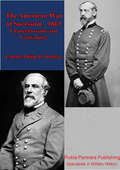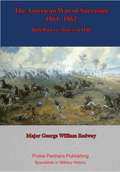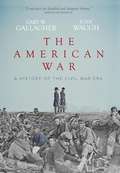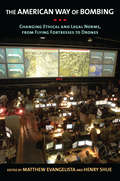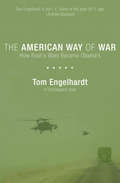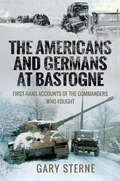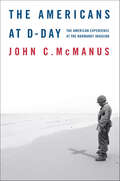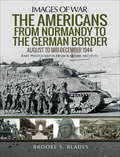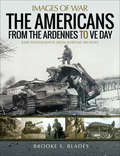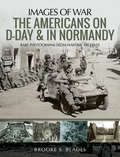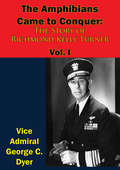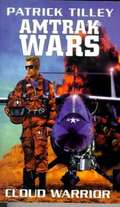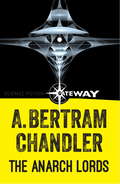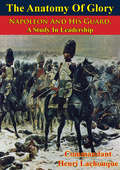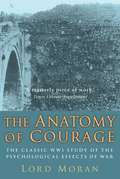- Table View
- List View
The American War Of Sucession – 1863 [Illustrated Edition]: Chancellorsville And Gettysburg (Special Campaigns Series #13)
by Colonel Philip H. DalbiacIncludes Civil War Map and Illustrations Pack - 224 battle plans, campaign maps, and detailed analyses of actions spanning the entire period of hostilities.The American Civil War had been raging since 1861. In the eastern theatre of the war, the Confederate forces - under the brilliant leadership of Robert E. Lee - traded blows with a succession of Union commanders and inflicted some severe losses on his enemy. In the period covered by the book--1963--the next commander, to try to wrest the initiative from the Confederates and utilise the numerical superiority of the Union forces, was Maj.-General Hooker. His attempt would founder catastrophically at the battle of Chancellorsville, which in turn might be described as General Lee's most famous victory. The high-water mark of the Confederate successes was to be at the battle of Gettysburg, with the Union forces under new commander General Meade holding their own and finally gaining the initiative.Although a short book, it is a revealing look at the campaign from an "out-side" point of view free from partisan bias.This book is part of the Special Campaigns series produced around the turn of the 20th century by serving or recently retired British and Indian Army officers. They were principally intended for use by British officers seeking a wider knowledge of military history.Title - The American War of Sucession - 1863 [Illustrated Edition]Sub-Title - Chancellorsville and GettysburgSeries Name - Special Campaigns SeriesSeries Number -- 13Author -- Colonel Philip H. Dalbiac (1855-1927)
The American War in Afghanistan: A History
by Carter MalkasianA New York Times Notable Book for 2021. The American war in Afghanistan, which began in 2001, is now the longest armed conflict in the nation's history. In this book, Carter Malkasian provides the first comprehensive history of the entire conflict up to the signing of the US-Taliban peace agreement in February 2020. Both a leading scholarly authority and an experienced, on-the-ground practitioner fluent in Pashto, Malkasian spent nearly two years working in the Afghan countryside prior to becoming the senior advisor to first the top US military commander in Afghanistan and later the Chairman of the Joint Chiefs of Staff. Drawing from a deep well of local knowledge and a rich array of primary sources, Malkasian moves through the war's multiple phases: the 2001 invasion and after; the resurgence of the Taliban in 2006; the Obama-era surge; and the various resets in strategy that occurred from 2011 onward, culminating in the 2018-2020 peace talks. Malkasian lived through most of it and draws from his own experiences to provide a truly unique perspective on the war. Today, the Taliban is the most powerful faction, and sees victory as probable. The ultimate outcome after America leaves is inherently unpredictable given the multitude of actors there, but one thing is sure: the war did not go as America had hoped. Although the al-Qaeda leader Osama bin Laden was killed and no major attack on the American homeland occurred after 2001, the United States was unable to end the violence or hand over the war to the Afghan authorities, which could not survive without US military backing. This book explains why the war had such a disappointing outcome. A wise and all-encompassing portrait of the conflict through all of its phases, The American War in Afghanistan will remain the authoritative account for years to come. CARTER MALKASIAN was the Special Assistant for Strategy to Joint Chiefs of Staff Chairman General Joseph Dunford from 2015 to 2019. He has extensive experience working in Afghanistan through multiple deployments throughout the country. The highlight of his work is the nearly two years he spent in Garmser district, Helmand province, Afghanistan, as a State Department political officer and the district stabilization team leader. He is the author of War Comes to Garmser: Thirty Years of Conflict on the Afghan Frontier (Oxford) and Illusions of Victory: The Anbar Awakening and the Rise of the Islamic State (Oxford). He has a doctorate in history from Oxford and is fluent in Pashto.
The American War of Sucession – 1861-1862 {Illustrated Edition]: Bull Run to Malvern Hill (Special Campaigns Series #11)
by Major George William RedwayThis ebook is purpose built and is proof-read and re-type set from the original to provide an outstanding experience of reflowing text for an ebook reader. Includes Civil War Map and Illustrations Pack - 224 battle plans, campaign maps, and detailed analyses of actions spanning the entire period of hostilities. An excellent account of the first two years of the American Civil War, Major Redway sifts through the wealth of material available to give a digestible interpretation of the events. It was during these two years that the attritional nature of the War was realised and both belligerents realised that the hostilities would be both long and bloody. In the Eastern Theatre, from the Battle of Bull Run, notable for the inexperience of the troops and the emergence of Thomas Jackson as a leader of the first order who gained his nickname "Stonewall" by his inspiring performance, to the Peninsula Campaign which forced the Union troops back from their attempt to assault Richmond. In the west, much blood was spilt on both sides, but the fighting was inconclusive and hardly decisive; Ulysses S. Grant was gaining much experience and profited by planning a number of minor victories. This book is part of the Special Campaigns series produced around the turn of the 20th century by serving or recently retired British and Indian Army officers. They were intended principally for use by British officers seeking a wider knowledge of military history. Title - The American War of Sucession - 1861-1862 Sub-Title - Bull Run to Malvern Hill Series Name - Special Campaigns Series Series Number --11 Author -- Major George William Redway (1859-1934) Text taken, whole and complete, from the edition published in 1910, London, by Swan Sonnenschein & Co. Original - viii and 392 pages. Illustrations - The maps cannot be reproduced with this volume as they are A3 - 224 additional maps have been added.
The American War: A History of the Civil War Era
by Gary W. Gallagher Joan WaughIn The American War, renowned historians Gary W. Gallagher and Joan Waugh provide a fresh examination of the Civil War, its aftermath, and enduring memory in a masterful work that prize-winning historian William C. Davis calls, "easily the best one-volume assessment of the Civil War to date." By investigating this crucial period through the eyes of civilians, celebrated leaders, and citizen soldiers, readers interested in the Civil War era will gain a profound understanding of the dramatic events, personalities, and social and economic processes that caused the war, enabled the Union to prevail, and forever transformed the United States. It also will help readers understand why, more than 150 years after Appomattox, it remains impossible to grasp the larger sweep of U.S. history without coming to terms with the American War.
The American Warfare State: The Domestic Politics of Military Spending (Chicago Series on International and Domestic Institutions)
by Rebecca U. ThorpeHow is it that the United States--a country founded on a distrust of standing armies and strong centralized power--came to have the most powerful military in history? Long after World War II and the end of the Cold War, in times of rising national debt and reduced need for high levels of military readiness, why does Congress still continue to support massive defense budgets? In The American Warfare State, Rebecca U. Thorpe argues that there are profound relationships among the size and persistence of the American military complex, the growth in presidential power to launch military actions, and the decline of congressional willingness to check this power. The public costs of military mobilization and war, including the need for conscription and higher tax rates, served as political constraints on warfare for most of American history. But the vast defense industry that emerged from World War II also created new political interests that the framers of the Constitution did not anticipate. Many rural and semirural areas became economically reliant on defense-sector jobs and capital, which gave the legislators representing them powerful incentives to press for ongoing defense spending regardless of national security circumstances or goals. At the same time, the costs of war are now borne overwhelmingly by a minority of soldiers who volunteer to fight, future generations of taxpayers, and foreign populations in whose lands wars often take place. Drawing on an impressive cache of data, Thorpe reveals how this new incentive structure has profoundly reshaped the balance of wartime powers between Congress and the president, resulting in a defense industry perennially poised for war and an executive branch that enjoys unprecedented discretion to take military action.
The American Way of Bombing: Changing Ethical and Legal Norms, from Flying Fortresses to Drones
by Matthew Evangelista Henry ShueAerial bombardment remains important to military strategy, but the norms governing bombing and the harm it imposes on civilians have evolved. The past century has seen everything from deliberate attacks against rebellious villagers by Italian and British colonial forces in the Middle East to scrupulous efforts to avoid "collateral damage" in the counterinsurgency and antiterrorist wars of today. The American Way of Bombing brings together prominent military historians, practitioners, civilian and military legal experts, political scientists, philosophers, and anthropologists to explore the evolution of ethical and legal norms governing air warfare. Focusing primarily on the United States--as the world's preeminent military power and the one most frequently engaged in air warfare, its practice has influenced normative change in this domain, and will continue to do so--the authors address such topics as firebombing of cities during World War II; the atomic attacks on Hiroshima and Nagasaki; the deployment of airpower in Iraq, Afghanistan, and Libya; and the use of unmanned drones for surveillance and attacks on suspected terrorists in Pakistan, Yemen, Sudan, Somalia, and elsewhere. Contributors: Tami Davis Biddle, U.S. Army War College; Sahr Conway-Lanz, Yale University Library; Neta C. Crawford, Boston University; Janina Dill, University of Oxford; Charles J. Dunlap Jr., Duke University; Matthew Evangelista, Cornell University; Charles Garraway, University of Essex; Hugh Gusterson, George Mason University; Richard W. Miller, Cornell University; Mary Ellen O'Connell, University of Notre Dame; Margarita H. Petrova, Institut Barcelona d'Estudis Internacionals; Klem Ryan, United Nations, South Sudan; Henry Shue, University of Oxford
The American Way of War: How Bush's Wars Became Obama's (TomDispatch Books)
by Tom EngelhardtThe creator of TomDispatch.com &“tackles our military fetish . . . He takes on our war-possessed world with clear-eyed, penetrating precision&” (Mother Jones).Tom Engelhardt, creator of the website TomDispatch.com, takes a scalpel to the American urge to dominate the globe. Tracing developments from 9/11 to present day, this is an unforgettable anatomy of a disaster that is yet to end.Since 2001, Tom Englehardt has written regular reports for his popular site TomDispatch that have provided badly needed insight into US militarism and its effects, both at home and abroad. When others were celebrating the invasions of Afghanistan and Iraq, he warned of the enormous dangers of both occupations.In The American Way of War, Engelhardt documents Washington&’s ongoing commitment to military bases to preserve—and extend—its empire; reveals damning information about the American reliance on air power, at great cost to civilians in Afghanistan, Iraq, and Pakistan; and shows that the US empire has deep historical roots that precede the Bush administration—and continued through the presidency of Barack Obama.Praise for Tom Engelhardt and The American Way of War&“Engelhardt is absorbing and provocative. Everything he writes is of a satisfyingly congruent piece.&” —The New York Times&“Tom Engelhardt provides a clear-eyed examination of U.S. foreign policy in the Bush and Obama years, and details unsparingly how Obama has inherited—and in many cases exacerbated—the ills of the Bush era.&” —Daniel Luban, Inter Press Service &“Tom Engelhardt is a national treasure and always worth reading.&” —Juan Cole, professor of history at the University of Michigan
The American West and the Nazi East
by III Carroll P. KakelBy employing new 'optics' and a comparative approach, this book helps us recognize the unexpected and unsettling connections between America's 'western' empire and Nazi Germany's 'eastern' empire, linking histories previously thought of as totally unrelated and leading readers towards a deep revisioning of the 'American West' and the 'Nazi East'.
The Americans and Germans at Bastogne: First-Hand Accounts of the Commanders Who Fought
by Gary SterneThis WWII oral history provides a fresh account of this famous episode in the Battle of the Bulge using declassified interviews with German commanders.In December of 1944, the Third Reich was in retreat and Allied victory was just around the corner—unless the Battle of the Bulge succeeded in turning the tide of the war. The US 101st Airborne were the only Allied unit capable of slowing the German advance towards Antwerp. And they were ordered to do just that at a small Belgium cross-roads town called Bastogne. In this volume, historian Gary Sterne offers a vivid account of the Siege of Bastogne using declassified interviews with the German unit commanders who took part. Brought together for the first time – these ground-level accounts provide a unique perspective on the battle as the Germans were forced to make continuous alterations to their plans.
The Americans at D-Day: The American Experience at the Normandy Invasion
by John C. McManusImpressively researched, engrossing, lightning quick, and filled with human sorrow and elation, John C. McManus's The Americans at D-Day honors those Americans who lost their lives on D-Day, as well as those who were fortunate enough to survive. June 6, 1944 was a pivotal moment in the history of World War II in Europe. On that day the climactic and decisive phase of the war began. Those who survived the intense fighting on the Normandy beaches found their lives irreversibly changed. The day ushered in a great change for the United States as well, because on D-Day, America began its march to the forefront of the Western world.By the end of the Battle of Normandy, almost one of every two soldiers involved was an American, and without American weapons, supplies, and leadership, the outcome of the invasion and ensuing battle could have been very different.In the first of two volumes on the American contribution to the Allied victory at Normandy, John C. McManus (Deadly Brotherhood, Deadly Sky) examines, with great intensity and thoroughness, the American experience in the weeks leading up to D-Day and on the great day itself. From the build up in England to the night drops of airborne forces behind German lines and the landings on the beaches at dawn, from the famed figures of Eisenhower, Bradley, and Lightin' Joe Collins to the courageous, but little-known privates who fought so bravely, and under terrifying conditions, this is the story of the American experience at D-Day. What were the battles really like for the Americans at Utah and Omaha? What drove them to fight despite all adversity? How and why did they triumph? Thanks to extensive archival research, and the use of hundreds of first hand accounts, McManus answers these questions and many more.In The Americans at D-Day, a gripping narrative history reminiscent of Cornelius Ryan's The Longest Day, McManus takes readers into the minds of American strategists, into the hearts of the infantry, into hell on earth.At the Publisher's request, this title is being sold without Digital Rights Management Software (DRM) applied.
The Americans from Normandy to the German Border: August to mid-December 1944 (Images of War)
by Brooke S. BladesRare World War II photographs detailing the massive American contribution to the 1944 campaign in northwest Europe from August to mid-December. Following the dramatic breakout from the Normandy bridgehead, events moved fast with the liberation of Paris quickly following and the Allies closed in on the German border. But the apparent collapse of the Nazis was illusory. As lines of communication lengthened and German resistance stiffened, the Allied High Command was divided on the right strategy. The ill-fated Operation Market Garden brought home the reality that the war would continue into 1945. The Siegfried Line was penetrated, and Aachen fell. But the American First Army suffered heavy casualties in the Hurtgen Forest. As winter set in, the third Army crossed the Moselle River and into the Saar. The stage was set for the costliest battle in American history—The Bulge, to be covered in the third and final volume of this trilogy. With his superb collection of images and grasp of the historic significance of the actions so graphically described, Brooke Blades&’s latest book will be appreciated by all with an interest in the final stages of the Second World War.
The Americans from the Ardennes to VE Day (Images of War)
by Brooke S. BladesA World War II pictorial history with over 250 rare photos showing the contribution of U.S. forces in northwest Europe from December 1944 to May 1945.Launched in December 1944, the Nazis’ Ardennes offensive, known as the Battle of the Bulge, was one of the most dangerous periods of the war. During six weeks of desperate fighting, more U.S. soldiers were killed, wounded, or reported missing than in any battle in American history.The Rhine was crossed in March 1945, first by the seizure of the railway bridge at Remagen and then by the combined American, British, and Canadian ground and airborne operation codenamed Varsity. In the closing stages of the war, the western allies pushed remorselessly in the heart of Germany. Shocking evidence of Nazi atrocities was uncovered.Berlin fell to the Russians in early May, and the Allies met up on the River Elbe. In the chaos that followed, Germany was divided into four zones of occupation. The immediate tasks were ensuring the survival of the civilian population, establishing law and order, and the capture of war criminals.In true Images of War style, this book graphically describes the magnificent role played by U.S. forces under General Eisenhower’s overall command.
The Americans on D-Day & in Normandy: Rare Photographs From Wartime Archives (Images of War)
by Brooke S. BladesA pictorial history of the United States&’s military operations in World War II, focused on the Battle of Normandy and the liberation of northern France. The experiences and achievements of the United States land, sea, and air forces on 6 June 1944 and the weeks following have been deservedly well chronicled. Omaha Beach saw the fiercest fighting of the whole OVERLORD invasion, and the opposition faced in the U.S. sector shocked commanders and men at all levels. The outcome was in the balance and, thanks to the courage and determination shown by the attackers, game-changing failure was narrowly averted. This superb Images of War book examines, using contemporary and modern images and maps, the course of the campaign and its implication for both the American troops and the civilian population of the battle zone. These revealing images, both color and black and white, are enhanced by full captions and the author&’s thoroughly researched text. The result is a graphic reminder of the liberation of Northern France and the extraordinary sacrifice made by men not just of the United States military but the other Allied nations.
The Americans on D-Day: A Photographic History of the Normandy Invasion
by Martin K. MorganExperience the Normandy invasion through some of D-Day’s most incredible photographs: “A rare contribution to our understanding of that historic event.” —Barrett Tillman, author of Brassey’s D-Day EncyclopediaAlthough it took a multinational coalition to conduct World War II’s amphibious D-Day landings, the US military made a major contribution to the operation that created mighty American legends and unforgettable heroes. In The Americans on D-Day: A Photographic History of the Normandy Invasion, WWII historian Martin K. A. Morgan presents 450 of the most compelling and dramatic photographs captured in northern France during the first day and week of its liberation.With eight chapters of place-setting author introductions, riveting period imagery, and highly detailed explanatory captions, Morgan offers anyone interested in D-Day a fresh look at a campaign that was fought many decades ago and yet remains the object of unwavering interest to this day. While some of these images are familiar, they have been treated anonymously for far too long and haven’t been placed within the proper context of time or place. Many others have never been published before. Together, these photographs reveal minute details about weapons, uniforms, and equipment, while simultaneously narrating an intimate human story of triumph, tragedy, and sacrifice. From Omaha Beach to Utah, from Sainte-Mère-Église to Pointe du Hoc, The Americans on D-Day is a striking visual record of the epic air, sea, and land battle that was the Normandy invasion.
The Amphibians Came to Conquer: The Story of Richmond Kelly Turner Vol. I (The Amphibians Came to Conquer: The Story of Richmond Kelly Turner #1)
by Vice Admiral George C. Dyer Rear Admiral Earnest McNeill EllerIncludes over 90 maps, charts and illustrations.His nickname was "Terrible Turner." He was, according to one ensign who served with him prior to World War II, "the meanest man I ever saw, and the most competent naval officer I ever served with." He led the successful amphibious attacks on Guadalcanal, Makin, Kwajalein, Roi-Namur, Saipan, Tinian, and Guam. He was Admiral Richmond Kelly Turner, one of the key figures in America's defeat of Japan. In this fascinating and comprehensive biography, Vice Admiral George C. Dyer documents the tough and fearless leadership of Admiral Turner, his astonishing success in meeting some of the toughest challenges in the history of amphibious warfare, and detailed descriptions of the ships and men who fought under him. More than just a biography, The Amphibians Came to Conquer is a carefully documented history, both strategic and tactical, of the major campaigns in the Pacific from Guadalcanal to Okinawa, providing a wealth of information on how Terrible Turner and the men he commanded conquered island after island against a tough and determined foe. In an astonishing tribute to the tenacity of Turner and his men, a February 21, 1945 Japanese broadcast said: "The true nature of an alligator is that once he bites into something, he will not let go. Turner's nature is also like this." This remarkable book belongs in the library of any serious student of the war in the Pacific
The Amphibians Came to Conquer: The Story of Richmond Kelly Turner Vol. II (The Amphibians Came to Conquer: The Story of Richmond Kelly Turner #2)
by Vice Admiral George C. Dyer Rear Admiral Earnest McNeill EllerIncludes over 110 maps, charts and illustrations.His nickname was "Terrible Turner." He was, according to one ensign who served with him prior to World War II, "the meanest man I ever saw, and the most competent naval officer I ever served with." He led the successful amphibious attacks on Guadalcanal, Makin, Kwajalein, Roi-Namur, Saipan, Tinian, and Guam. He was Admiral Richmond Kelly Turner, one of the key figures in America's defeat of Japan. In this fascinating and comprehensive biography, Vice Admiral George C. Dyer documents the tough and fearless leadership of Admiral Turner, his astonishing success in meeting some of the toughest challenges in the history of amphibious warfare, and detailed descriptions of the ships and men who fought under him. More than just a biography, The Amphibians Came to Conquer is a carefully documented history, both strategic and tactical, of the major campaigns in the Pacific from Guadalcanal to Okinawa, providing a wealth of information on how Terrible Turner and the men he commanded conquered island after island against a tough and determined foe. In an astonishing tribute to the tenacity of Turner and his men, a February 21, 1945 Japanese broadcast said: "The true nature of an alligator is that once he bites into something, he will not let go. Turner's nature is also like this." This remarkable book belongs in the library of any serious student of the war in the Pacific.
The Amtrak Wars, Book 1: Cloud Warrior
by Patrick TilleyTen centuries ago the Old Time ended when Earth's cities melted in the War of a Thousand Suns. Now the lethal high technology of the Amtrak Federation's underground stronghold is unleashed on Earth's other survivors - the surface-dwelling Mutes. But the primitive Mutes possess ancient powers greater than any machine...
The Amtrak Wars, Book 2: First Family
by Patrick TilleyAfter countless years of fighting - of pitting sophistticated technology against the primitive surface-dwelling people who seemed to possess supernatural powers - the Federation was still no nearer to ending the battle with the Mutes. But then a lone flier was hauled into one of its underground bunkers - a man whose very existence was a challenge to the all-pervading wisdom of the First Family. A man whose destiny would determine the future for both the Federation and the Mutes...
The Amtrak Wars, Book 5: Death-bringer
by Patrick TilleyWith Clearwater now safely in their hands, the Federation hatches a plan to capture Cadillac and Mr Snow and annihilate the Clan McCall: a plan which forces Steve to continue his double role as loyal agent of the Federation and blood-brother to the Mutes. The First Family is hell-bent on exacting retribution for past defeats but the twice-bloodied House of Yama-Shita is also thirsting for vengeance. Both parties blindly pursue their own ends unaware that the outcome is governed not by force of arms but by the irrevocable power of prophecy.
The Anabasis of Cyrus: Or, The Expedition Of Cyrus (Agora Editions)
by Xenophon Wayne Ambler Eric BuzzettiOne of the foundational works of military history and political philosophy, and an inspiration for Alexander the Great, the Anabasis of Cyrus recounts the epic story of the Ten Thousand, a band of Greek mercenaries hired by Cyrus the Younger to overthrow his brother, Artaxerxes, king of Persia and the most powerful man on earth. It shows how Cyrus' army was assembled covertly and led from the coast of Asia Minor all the way to Babylon; how the Greeks held the field against a superior Persian force; how Cyrus was killed, leaving the Greeks stranded deep within enemy territory; and how many of them overcame countless dangers and found their way back to Greece.Their remarkable success was due especially to the wily and decisive leadership of Xenophon himself, a student of Socrates who had joined the Ten Thousand and, after most of the Greek generals had been murdered, rallied the despondent Greeks, won a position of leadership, and guided them wisely through myriad obstacles.In this new translation of the Anabasis, Wayne Ambler achieves a masterful combination of liveliness and a fidelity to the original uncommon in other versions. Accompanying Ambler's translation is a penetrating interpretive essay by Eric Buzzetti, one that shows Xenophon to be an author who wove a philosophic narrative into his dramatic tale. The translation and interpretive essay encourage renewed study of the Anabasis as a work of political philosophy. They also celebrate its high adventure and its hero's adroit decision-making under the most pressing circumstances.
The Anarch Lords (John Grimes)
by A. Bertram ChandlerHis wild career as a space pirate ended, Grimes faced his toughest assignment - he was "punished" by being made governor of the anarchists' own planet! John Grimes, living legend of the spaceways, had been in and out of some cosmic catastrophes but this threatened to reach his luck's ultimate breaking point!An influx of planetary refugees had made that world a paradise of cheap labor and the original anarchist colonists had become such masters of wealth that no mere outsider could hope to dictate "law and order" to them. They had their own ideas which included slavery, treachery, and utter villainy.Grimes' first task as governor would be simply to stay alive with a whole world plotting his murder!
The Anarchy of Nazi Memorabilia: From Things of Tyranny to Troubled Treasure (Material Culture and Modern Conflict)
by Michael HughesCompared to the numerous books and articles on the Third Reich, few address its material culture, and fewer still discuss the phenomenon of Nazi memorabilia. This is all the more surprising given that Nazi symbols, so central to sustaining Hitler’s movement, continue to live long after the collapse of his 12-year Reich. Neither did Nazi ideology die, far-right populists would like to see the swastika flown over the White House or Buckingham Palace. Against a backdrop of right-wing extremism, military re-enactors think nothing of dressing up in Waffen-SS uniforms and romanticising the Third Reich in the name of living history. Auctioneers are prepared to hammer down Nazi artefacts to the highest bidder, but who is buying them, and why do they do so? Should collectors be allowed to decorate their homes with Nazi flags? The Anarchy of Nazi Memorabilia begins by examining the creation and context of Nazi artefacts and symbols during the volatile Weimar Republic to their wider distribution during the Third Reich. There were few people in Nazi Germany who did not wear a badge or uniform of some sort. Whether it be mothers, soldiers or concentration camp inmates, they were all branded. The chapter on the Second World War even demonstrates that German soldiers were highly cynical about being given medals in exchange for freezing in Russia. They still continued to fight, however, for which more decorations were awarded. A large proportion of this book is therefore given to the meaning that Nazi symbols had before Nazi Germany was eventually defeated in May 1945. Equally important, however, and one of the characteristics of this book, is the analysis of the meaning and value of Nazi material culture over time. The interpreters of Nazi symbols that this book focuses on are internationally based private collectors and traders. Sustained attention is given in a chapter outlining the development of the collectors’ market for Nazi memorabilia from 1945 onwards. No matter how much collectors go out of their way to paint the hobby in a positive light, their activities are not fully able to escape the troubled past of the material that they desire. So contested are Nazi symbols, that another chapter is devoted to the ethics and morals of destroying or preserving them. As part of this chapter the issues surrounding private versus public custody and ownership of Nazi artefacts are also discussed. So far, in this book, the examination of Nazi artefacts has been restricted to physical objects within societies that are generally aware of the consequences of Hitlerism. As we increasingly move into the digital age, however, and there are few survivors of the Second World War left to relay their horrific experiences, the final chapter contemplates the future of Nazi symbols both digitally and physically, fake or real. This book will appeal to all those interested in the Third Reich, Nazi Ideology, Neo-Nazism, perceptions of the Nazis post-1945, Modern European History and political symbolism. It will also hold particular appeal to those interested in the collecting and trading of contested and highly emotive artefacts. It considers aesthetics, authenticity, commodification, gift exchange, life histories of people and objects, materiality and value theory.
The Anatomy Of Glory; Napoleon And His Guard, A Study In Leadership
by Anne S. K. Brown Commandant Henri LachouqueThe glory of the Imperial Guard resounds above all others in the annals of war. Created, built and nurtured as a bodyguard for Napoleon, it grew from a brigade of less than two thousand men into a virtual army, and became ‘a human fortress which no one but he could dominate and no enemy could penetrate’. And, on such battlefields as Austerlitz, Jena, Friedland, Wagram and Waterloo, it won the laurels of undying fame.Written by France’s foremost historian of the Napoleonic Wars, Commandant Henry Lachouque, and translated and adapted by Anne S. K. Brown, this sumptuous work is enhanced by over 180 illustrations, including 86 plates in full colour.With its vivid narrative and lavish illustrations, The Anatomy of Glory can lay justifiable claim to be one of the most magnificent books on military history ever published. The critical acclaim that greeted it upon its first publication provides ample testimony to its reputation:‘This dramatic account of the birth, life and death of the fabulous Imperial Guard tells a stirring story in English for the first time.’-The Saturday Review of Literature.‘No one but the most presumptuous who wishes to know about the Imperial Guard can afford to ignore this astonishing compilation. The illustrations alone...are reproduced with a clarity, a beauty, and technical perfection which no one can fail to admire.’ Journal of the RUSI.‘This sumptuous book ... can yield rich rewards to any reader interested in the fabric of leadership. It is a delight to look at and a pleasure to read.’ -The New York Times.`... Not the well-worn history of conquest and defeat, but of the grognards themselves, marching through readable pages.’ -History Today.‘Anne S. K. Brown has used her knowledge of French history and uniforms to render Lachouque freely and vigorously. Napoleon just happened to be fallible. But the superb apparatus of his fallibility is gorgeously recalled in this volume.’ The Scotsman.
The Anatomy of Courage: The Classic WWI Study of the Psychological Effects of War
by John Moran'I set out to find how courage is born and how it is sustained in a modern army of a free people. The soldier is alone in his war with terror and we have to recognise the first signs of his defeat, that we may come in time to his rescue.' Lord MoranFirst published in 1945 this early, groundbreaking account of the psychological effects of war, recounted by means of vivid first-hand observation and anecdote, came at a time when shell-shock was equated with lack of moral fibre. In 1940, Moran became Churchill's doctor and his position as a one of history's most important war physicians was secured. His humane, considered observations, scientific analysis and proposed solutions constitute one of the great First World War sources. However, they are perhaps just as relevant to our own conflict-ridden times.Charles McMoran Wilson was awarded the MC during the Battle of the Somme and the Italian Silver Medal for Military Valour. He was the Dean of St Mary's Hospital Medical School, became Winston Churchill's doctor in 1940 and was President of the Royal College of Physicians. He is also the author of Churchill: The Struggle for Survival and Churchill at War.PRAISE FOR THE ANATOMY OF COURAGE'A remarkably human book ... arresting, and sometimes even unforgettable.' Desmond McCarthy, Sunday Times'A fascinating book ... It is not easy to do justice to Lord Moran's discursive brilliancy ... a masterly piece of work.' Times Literary Supplement
The Anatomy of Courage: The Classic WWI Study of the Psychological Effects of War
by Lord John Moran'A remarkably human book . . . arresting, and sometimes even unforgettable' Desmond McCarthy, Sunday Times'A fascinating book . . . It is not easy to do justice to Lord Moran's discursive brilliancy . . . a masterly piece of work' Times Literary Supplement'I set out to find how courage is born and how it is sustained in a modern army of a free people. The soldier is alone in his war with terror and we have to recognise the first signs of his defeat, that we may come in time to his rescue' LORD MORANDuring the First World War, Lord Moran served as a medical officer in the Royal Fusiliers for two-and-a-half years. He won the Military Cross and the Italian Silver Medal for Valour. During these years in the trenches he watched closely the soldiers' conduct under stress. The Anatomy of Courage is his sensitive and scientific study of fear and anxiety. First published in 1945 this early, ground-breaking account of the psychological effects of war, recounted by means of vivid first-hand observation and anecdote, came at a time when shell-shock was equated with lack of moral fibre. In 1940, Moran became Churchill's doctor and his position as a one of history's most important war physicians was secured. His humane, considered observations, scientific analysis and proposed solutions constitute one of the great First World War sources. However, they are perhaps just as relevant to our own conflict-ridden times.
